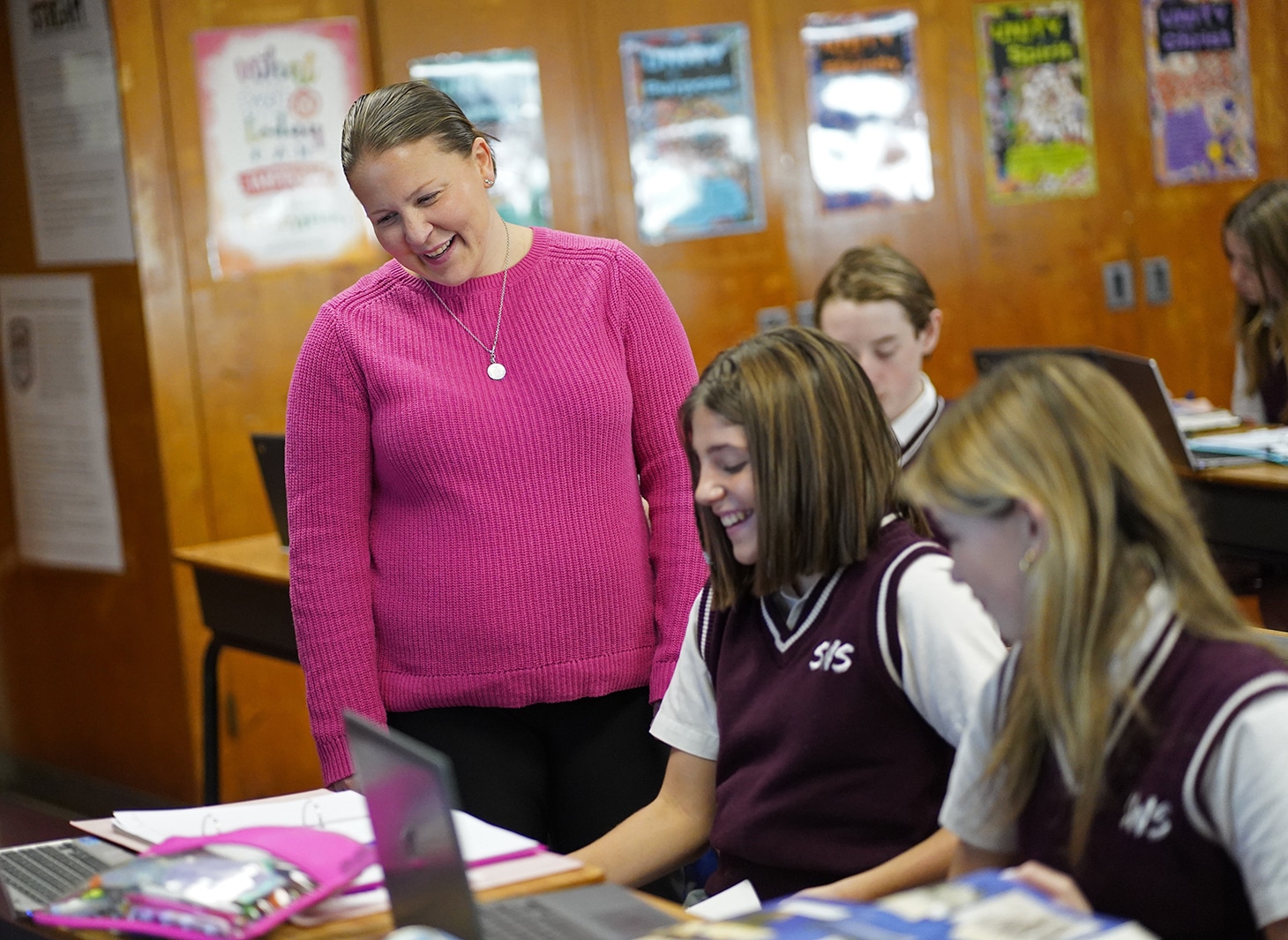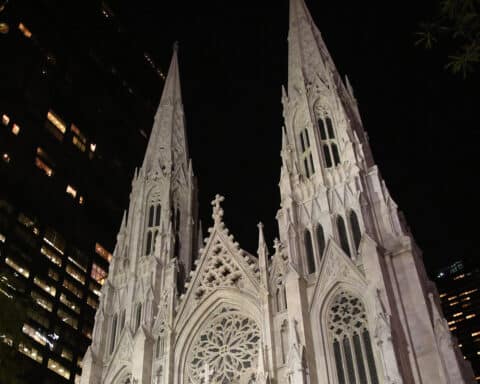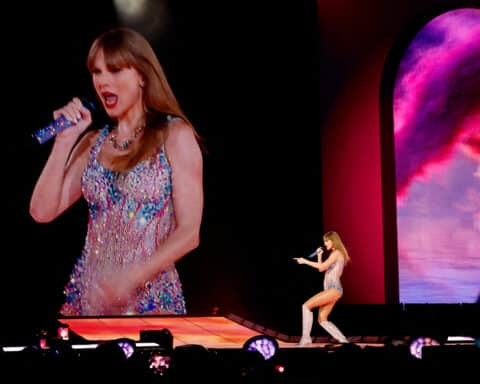(OSV News) — In September, about 120 students from states in Eastern and Central time zones logged into classes at Marian University Preparatory School, a virtual K-12 Catholic school launched in 2022 by Marian University in Indianapolis. Some students chose the school’s hybrid option, with in-person classes multiple times per month at Marian University’s campus.
Students attend the school full time or choose classes a la carte to complement at-home learning, said Elisha Schlabach, MU Prep’s head of school. The school also partners with five traditional-model Catholic schools in Indiana to provide virtual classes in particular subject areas or for individual students.
“I certainly think it’s unique,” Schlabach said of the school’s hybrid model, especially with its ties to the university. “Families are finding that the traditional model of brick-and-mortar isn’t for everybody. … What this is doing is allowing families to take a more active approach in their choice for how their child is going to learn and what that educational setting looks like.”
Creative approaches to Catholic education are signs that Catholic schools are adapting to new needs, said Mary Pat Donoghue, executive director of the Secretariat of Catholic Education for the U.S. Conference of Catholic Bishops. Those needs continue to be impacted by the COVID-19 pandemic, which became an inflection point for U.S. education.
Pandemic drove interest
“Catholic education is at an interesting moment, and I think it’s a moment of great opportunity,” Donoghue told OSV News. “The pandemic was difficult for us and very challenging. But it also shone a light on American education writ large.”
The pandemic prompted some families to consider Catholic education seriously for the first time “and what they saw in us was the strong community,” she said. “They saw site-based decisions, they saw a real mission-driven concern for the well-being of the child. All of those things just put out to the wider culture this idea that Catholic education is something unique and it is worth taking a look at.”
As U.S. Catholic schools prepare to celebrate Catholic Schools Week Jan. 28-Feb. 3, national Catholic school experts told OSV News that school leaders should be thinking deeply about Catholic mission and creatively about partnerships, including with the current boom in homeschooling.
One trend Donoghue has observed is “more of an interest in the Catholic mission, not simply Catholic identity or how we teach faith, but actually how our entire mission reflects the Church’s salvific mission,” she said. “For Catholic schools, at heart, our mission is to transmit a convincing vision of life in Jesus Christ.”
According to the National Catholic Educational Association’s 2022-2023 enrollment report — the organization’s most recently published data — Catholic school enrollment grew for the second consecutive year, increasing 0.3% in the 2022-2023 academic year, resulting in nearly 1.7 million students in more than 5,900 schools nationwide.
Among the NCEA report’s findings is that “Catholic schools have adapted to the nation’s changing needs by expanding their offerings in recent years.” It notes that among Catholic schools nationwide there are seven virtual Catholic schools, 99 International Baccalaureate programs and 125 dual language immersion programs, with the nation’s western regions having “the most offerings.”
While NCEA data for the 2023-2024 academic year has yet to be published, Donoghue said “it seems that enrollment is fairly stable.”
Homeschooling and co-ops
“Catholic education can and will look different in the years to come, and we are seeing a tremendous growth in homeschooling, for example … and small co-ops and microschools,” she said. “We need to pay attention to that and figure out how we might work to support families that are in different situations.”
While principal at St. Jerome Academy in the Washington suburb of Hyattsville, Maryland, where she led the school’s revival, Donoghue enrolled homeschooled students in particular classes, such as math or science, or extracurriculars, such as band and choir.
“One lady who had a number of boys sent them for PE (physical education), and I totally got that,” she said.
Catholic schools are also responding, Donoghue said, to the goals behind the U.S. bishops’ plan, affirmed at their 2023 June meeting, to draft a new pastoral statement on “persons with disabilities in the life of the church.”
“The (USCCB’s) committee on Catholic ed is really taking this up as a call to promote and encourage and support our schools, and expanding their capacity to receive children with different learning needs and different disabilities,” she said.
Daryl Hagan, interim director of the Institute for the Transformation of Catholic Education at The Catholic University of America in Washington, said Catholic schools are “in a renewal right now” and “great things are happening all across the United States.” That renewal, he said, is supported by momentum behind state school choice policies and Catholic school accreditation.
ITCE is piloting Lumen Accreditation, the first national Catholic accreditation agency, in the 93 Catholic schools in the Archdiocese of St. Paul and Minneapolis; Cathedral High School in Indianapolis; and St. John Paul the Great Catholic High School in Denver, with an additional 187 schools identified for the 2024-2025 academic year, Hagan said.
The accreditation is based on a framework of guiding principles for Catholic elementary and high schools.
“As you get more students as your schools continue to thrive, it’s imperative that our local school communities, our local parishes, ensure that our Catholic schools are just that — that they’re distinctly Catholic,” Hagan said.
Teacher shortages
John Staud, executive director of the Alliance for Catholic Education and a fellow at the Institute for Educational Initiatives at the University of Notre Dame in Indiana, sees significant opportunities and challenges ahead for Catholic schools. He said all schools, including Catholic schools, are facing significant teacher shortages, which could ultimately force some Catholic schools to close.
Compounding the situation, he said, is the fact that fewer college graduates are pursuing careers in education — a “pipeline problem” that persisted before the pandemic. A 2022 Pew Research Center survey found the number of college graduates conferred with a bachelor’s in education in 2019-2020 dropped 19% from where it was in 2000-2001.
Catholic schools also typically pay teachers less than their public counterparts, but increasing teachers’ salaries and keeping schools “available to all families who desire them” with affordable tuition puts many schools in difficult situations, Staud said.
Meanwhile, the number of Americans who do not identify with any religion continues to grow, which likely leads to less interest in faith-based education for their children, he said.
Longing for community
“In the midst of this, I think there are some signs of deep hope,” Staud said. “People long for a sense of community, and Catholic schools are expert in establishing these caring, nurturing communities, where children are known by name and respected and cared for in a special way.”
“Because we believe that all human beings are made in the image and likeness of God, they (Catholic schools) actually provide an important sense of purpose and meaning in a society that is increasingly kind of disjointed and lost in many ways,” he added.
Catholic schools’ adaptation to emerging needs reflects their original vision, when they were founded in reaction to the “Protestant ethic” in America’s public schools, Donoghue said. And while some schools — like MU Prep — are finding success with online programs, traditional parochial schools are still essential, she said.
“They are a visible sign of our connection (in the community) to the church’s mission, so I think there will always be a place for that,” she said. “But I also think as the world changes, the church should do what she’s always done, which is be responsive.”





